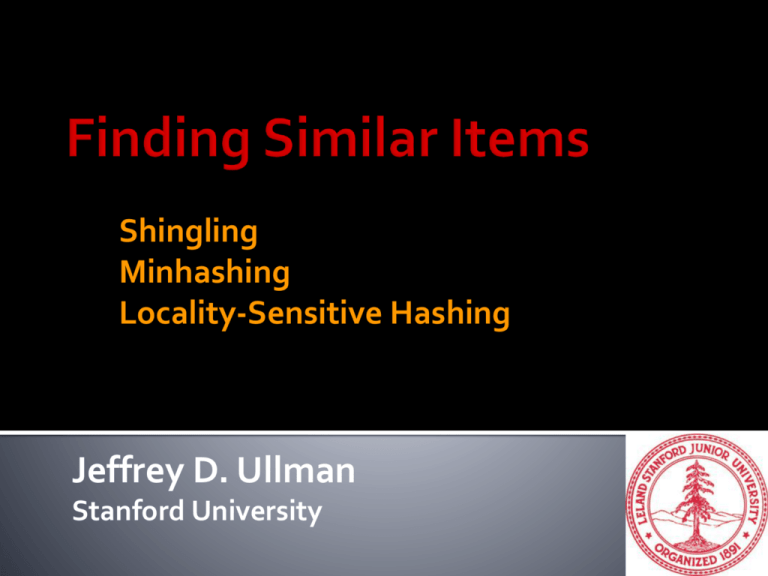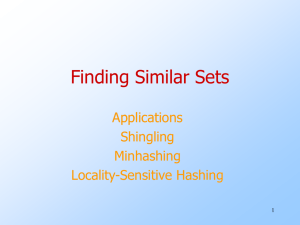(3) for - The Stanford University InfoLab
advertisement

Shingling
Minhashing
Locality-Sensitive Hashing
Jeffrey D. Ullman
Stanford University
Wednesday, January 13
Computer Forum Career Fair
11am - 4pm
Lawn between the Gates and Packard Buildings
Policy for HW2 regarding tagging of
subproblems:
Do it.
There will be deductions of up to 5 points for failure
to tag, minus another 2 points if the cover sheet is
missing.
2
It has been said that the mark of a computer
scientist is that they believe hashing is real.
I.e., it is possible to insert, delete, and lookup items
in a large set in O(1) time per operation.
Locality-Sensitive Hashing (LSH) is another type
of magic that, like Bigfoot, is hard to believe is
real, until you’ve seen it.
It lets you find pairs of similar items in a large
set, without the quadratic cost of examining
each pair.
3
LSH is really a family of related techniques.
In general, one throws items into buckets using
several different “hash functions.”
You examine only those pairs of items that
share a bucket for at least one of these
hashings.
Upside: designed correctly, only a small fraction
of pairs are ever examimed.
Downside: there are false negatives – pairs of
similar items that never even get considered.
4
We shall first study in detail the problem of
finding (lexically) similar documents.
Later, two other problems:
Entity resolution (records that refer to the same
person or other entity).
News-article similarity.
5
Given a body of documents, e.g., the Web,
find pairs of documents with a lot of text in
common, such as:
Mirror sites, or approximate mirrors.
Application: Don’t want to show both in a search.
Plagiarism, including large quotations.
Similar news articles at many news sites.
Application: Cluster articles by “same story.”
6
1.
2.
3.
Shingling: convert documents, emails, etc., to
sets.
Minhashing: convert large sets to short
signatures (lists of integers), while preserving
similarity.
Locality-sensitive hashing: focus on pairs of
signatures likely to be similar.
7
Localitysensitive
Hashing
Document
The set
of strings
of length k
that appear
in the document
Signatures:
short integer
vectors that
represent the
sets, and
reflect their
similarity
Candidate
pairs:
those pairs
of signatures
that we need
to test for
similarity.
8
A k -shingle (or k -gram) for a document is a
sequence of k characters that appears in the
document.
Example: k = 2; doc = abcab. Set of 2-shingles =
{ab, bc, ca}.
Represent a doc by its set of k-shingles.
9
Documents that are intuitively similar will have
many shingles in common.
Changing a word only affects k-shingles within
distance k-1 from the word.
Reordering paragraphs only affects the 2k
shingles that cross paragraph boundaries.
Example: k=3, “The dog which chased the cat”
versus “The dog that chased the cat”.
Only 3-shingles replaced are g_w, _wh, whi, hic, ich,
ch_, and h_c.
10
Intuition: want enough possible shingles that
most docs do not contain most shingles.
Character strings are not “random” bit strings,
so they take more space than needed.
k = 8, 9, or 10 is often used in practice.
11
To save space but still make each shingle rare,
we can hash them to (say) 4 bytes.
Called tokens.
Represent a doc by its tokens, that is, the set
of hash values of its k-shingles.
Two documents could (rarely) appear to have
shingles in common, when in fact only the
hash-values were shared.
12
The Jaccard similarity of two sets is the size of
their intersection divided by the size of their
union.
Sim(C1, C2) = |C1C2|/|C1C2|.
14
3 in intersection.
8 in union.
Jaccard similarity
= 3/8
15
Rows = elements of the universal set.
Examples: the set of all k-shingles or all tokens.
Columns = sets.
1 in row e and column S if and only if e is a
member of S; else 0.
Column similarity is the Jaccard similarity of
the sets of their rows with 1.
Typical matrix is sparse.
16
C1 C2
0 1
*
1 0
*
1 1 * *
0 0
1 1 * *
0 1
*
Sim(C1, C2) =
2/5 = 0.4
17
Given columns C1 and C2, rows may be classified as:
a
b
c
d
C1
1
1
0
0
C2
1
0
1
0
Also, a = # rows of type a , etc.
Note Sim(C1, C2) = a/(a +b +c ).
18
Permute the rows.
Thought experiment – not real.
Define minhash function for this permutation,
h(C) = the number of the first (in the permuted
order) row in which column C has 1.
Apply, to all columns, several (e.g., 100)
randomly chosen permutations to create a
signature for each column.
Result is a signature matrix: columns = sets,
rows = minhash values, in order for that column.
19
6
3
1
7
2
5
4
7
6
5
4
3
2
1
1
2
3
4
5
6
7
0
0
1
0
0
1
0
1
0
0
1
0
1
0
1
1
0
0
0
0
1
0
1
0
1
1
0
0
3 1 1
2
2 2 1 3
1 5 3 2
Signature Matrix
Input Matrix
20
People sometimes ask whether the minhash
value should be the original number of the row,
or the number in the permuted order (as we
did in our example).
Answer: it doesn’t matter.
You only need to be consistent, and assure that
two columns get the same value if and only if
their first 1’s in the permuted order are in the
same row.
21
The probability (over all permutations of the
rows) that h(C1) = h(C2) is the same as
Sim(C1, C2).
Both are a/(a+b+c)!
Why?
Look down the permuted columns C1 and C2 until
we see a 1.
If it’s a type-a row, then h(C1) = h(C2). If a type-b or
type-c row, then not.
22
The similarity of signatures is the fraction of the
minhash functions (rows) in which they agree.
Thus, the expected similarity of two signatures
equals the Jaccard similarity of the columns or
sets that the signatures represent.
And the longer the signatures, the smaller will be the
expected error.
23
Columns 1 & 2:
Jaccard similarity 1/4.
Signature similarity 1/3
Columns 2 & 3:
Jaccard similarity 1/5.
Signature similarity 1/3
Columns 3 & 4:
Jaccard similarity 1/5.
Signature similarity 0
0
0
1
0
0
1
0
1
0
0
1
0
1
0
1
1
0
0
0
0
1
0
1
0
1
1
0
0
3 1 1
2
2 2 1 3
1 5 3 2
Signature Matrix
Input Matrix
24
Suppose 1 billion rows.
Hard to pick a random permutation of
1…billion.
Representing a random permutation requires
1 billion entries.
Accessing rows in permuted order leads to
thrashing.
25
A good approximation to permuting rows:
pick, say, 100 hash functions.
Intuition: the hash of the row numbers is the
order of the corresponding permutation.
For each column c and each hash function hi,
keep a “slot” M(i, c).
Intent: M(i, c) will become the smallest value
of hi (r) for which column c has 1 in row r.
26
for each row r do begin
for each hash function hi do
compute hi (r);
for each column c
if c has 1 in row r
for each hash function hi do
if hi (r) is smaller than M(i, c) then
M(i, c) := hi (r);
end;
27
Row
1
2
3
4
5
C1
1
0
1
1
0
C2
0
1
1
0
1
h(x) = x mod 5
g(x) = (2x+1) mod 5
Sig1
h(1) = 1 1
g(1) = 3 3
Sig2
∞
∞
h(2) = 2 1
g(2) = 0 3
2
0
h(3) = 3
g(3) = 2
1
2
2
0
h(4) = 4 1
g(4) = 4 2
2
0
h(5) = 0 1
g(5) = 1 2
0
0
28
Often, data is given by column, not row.
Example: columns = documents, rows = shingles.
If so, sort matrix once so it is by row.
29
Remember: we want to hash objects such as
signatures many times, so that “similar” objects
wind up in the same bucket at least once, while
other pairs rarely do.
Candidate pairs are those that share a bucket.
Pick a similarity threshold t = fraction of rows in
which the signatures agree to define “similar.”
Trick: divide signature rows into bands.
Each hash function based on one band.
31
One
signature
r rows
per band
b bands
Matrix M
32
Divide matrix M into b bands of r rows.
For each band, hash its portion of each column
to a hash table with k buckets.
Make k as large as possible.
Candidate column pairs are those that hash to
the same bucket for ≥ 1 band.
Tune b and r to catch most similar pairs, but few
nonsimilar pairs.
33
Columns 2 and 6
are probably identical
in this band.
Buckets
Columns 6 and 7 are
surely different.
r rows
b bands
Matrix M
34
Suppose 100,000 columns.
Signatures of 100 integers.
Therefore, signatures take 40Mb.
Want all 80%-similar pairs.
5,000,000,000 pairs of signatures can take a
while to compare.
Choose 20 bands of 5 integers/band.
35
Probability C1, C2 identical in one particular
band: (0.8)5 = 0.328.
Probability C1, C2 are not similar in any of the 20
bands: (1-0.328)20 = .00035 .
i.e., about 1/3000th of the 80%-similar underlying
sets are false negatives.
36
Probability C1, C2 identical in any one particular
band: (0.4)5 = 0.01 .
Probability C1, C2 identical in ≥ 1 of 20 bands:
1 – (0.99)20 < 0.2 .
But false positives much lower for similarities
<< 40%.
37
Probability
= 1 if s > t
Probability
of sharing
a bucket
No chance
if s < t
t
Similarity s of two sets
38
Remember:
probability of equal
minhash values
= Jaccard similarity
False
negatives
Probability
of sharing
a bucket
Say “yes” if you
are below the line.
False
positives
t
Similarity s of two sets
39
At least
one band
identical
t ~ (1/b)1/r
Probability
of sharing
a bucket
t
No bands
identical
1 - ( 1 - s r )b
Some row All rows
of a band of a band
are equal
unequal
Similarity s of two sets
40
s
.2
.3
.4
.5
.6
.7
.8
1-(1-sr)b
.006
.047
.186
.470
.802
.975
.9996
41
Tune b and r to get almost all pairs with
similar signatures, but eliminate most pairs
that do not have similar signatures.
Check that candidate pairs really do have
similar signatures.
Optional: In another pass through data, check
that the remaining candidate pairs really
represent similar sets.
42
The entity-resolution problem is to examine a
collection of records and determine which refer
to the same entity.
Entities could be people, events, etc.
Typically, we want to merge records if their
values in corresponding fields are similar.
44
I once took a consulting job solving the
following problem:
Company A agreed to solicit customers for Company
B, for a fee.
They then argued over how many customers.
Neither recorded exactly which customers were
involved.
45
Each company had about 1 million records
describing customers that might have been
sent from A to B.
Records had name, address, and phone, but for
various reasons, they could be different for the
same person.
E.g., misspellings, but there are many sources of
error.
46
Step 1: Design a measure (“score ”) of how
similar records are:
E.g., deduct points for small misspellings (“Jeffrey”
vs. “Jeffery”) or same phone with different area
code.
Step 2: Score all pairs of records that the LSH
scheme identified as candidates; report high
scores as matches.
47
Problem: (1 million)2 is too many pairs of
records to score.
Solution: A simple LSH.
Three hash functions: exact values of name,
address, phone.
Compare iff records are identical in at least one.
Misses similar records with a small differences in
all three fields.
48
Problem: How do we hash strings such as
names so there is one bucket for each string?
Answer: Sort the strings instead.
Another option was to use a few million
buckets, and deal with buckets that contain
several different strings.
49
We were able to tell what values of the scoring
function were reliable in an interesting way.
Identical records had an average creation-date
difference of 10 days.
We only looked for records created within 90
days of each other, so bogus matches had a 45day average difference in creation dates.
50
By looking at the pool of matches with a fixed
score, we could compute the average timedifference, say x, and deduce that fraction
(45-x)/35 of them were valid matches.
Alas, the lawyers didn’t think the jury would
understand.
51
Any field not used in the LSH could have been
used to validate, provided corresponding values
were closer for true matches than false.
Example: if records had a height field, we would
expect true matches to be close, false matches
to have the average difference for random
people.
52
The Political-Science Dept. at Stanford asked a
team from CS to help them with the problem of
identifying duplicate, on-line news articles.
Problem: the same article, say from the
Associated Press, appears on the Web site of
many newspapers, but looks quite different.
54
Each newspaper surrounds the text of the
article with:
It’s own logo and text.
Ads.
Perhaps links to other articles.
A newspaper may also “crop” the article (delete
parts).
55
The team came up with its own solution, that
included shingling, but not minhashing or
LSH.
A special way of shingling that appears quite good
for this application.
LSH substitute: candidates are articles of similar
length.
56
I told them the story of minhashing + LSH.
They implemented it and found it faster for
similarities below 80%.
Aside: That’s no surprise. When the similarity
threshold is high, there are better methods – see
Sect. 3.9 of MMDS.
57
Their first attempt at minhashing was very
inefficient.
They were unaware of the importance of
doing the minhashing row-by-row.
Since their data was column-by-column,
they needed to sort once before
minhashing.
58
The team observed that news articles have a lot
of stop words, while ads do not.
“Buy Sudzo” vs. “I recommend that you buy Sudzo
for your laundry.”
They defined a shingle to be a stop word and
the next two following words.
59
By requiring each shingle to have a stop word,
they biased the mapping from documents to
shingles so it picked more shingles from the
article than from the ads.
Pages with the same article, but different ads,
have higher Jaccard similarity than those with
the same ads, different articles.
60






